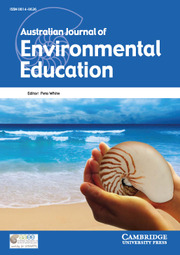Article contents
Hyperobjects, Media, and Assemblages of Collective Living: Playing With Ontology as Environmental Education
Published online by Cambridge University Press: 03 October 2019
Abstract
This article emphasises the importance of creative thought for environmental education through a discussion of the ontologically rich work of Anna Tsing, Timothy Morton and John Peters. The recent turn toward ontology in the humanities and social sciences has consequently led to diverse theories about ‘how things are’, and some of these concepts might assist justice-oriented environmental educators in raising ecological awareness in a time of crisis. Using assemblages, media and hyperobjects as concepts to (re)imagine the the world(s) of the Anthropocene, this article promotes a practice of ontic-play, a constantly changing engagement with ontological thought. To think through ecological crisis means moving towards philosophy as creation or art. In other words, engaging thought from the future.
Information
- Type
- Article
- Information
- Australian Journal of Environmental Education , Volume 35 , Special Issue 3: Environmental education and philosophy in the Anthropocene , November 2019 , pp. 213 - 221
- Copyright
- © The Author(s) 2019. Published by Cambridge University Press
References
- 2
- Cited by


